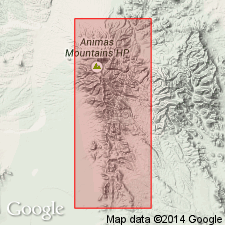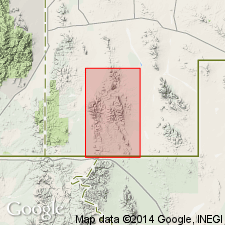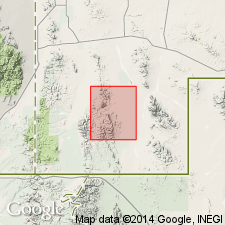
- Usage in publication:
-
- Animas stock
- Modifications:
-
- First used
- Dominant lithology:
-
- Quartz monzonite
- Porphyry
- AAPG geologic province:
-
- Pedregosa basin
Summary:
Animas stock. First use of name. Is an irregular, funnel-shaped intrusive of quartz monzonite porphyry located in Animas Range, north-central part of Walnut Wells quad, Hidalgo Co, NM. Is about 4 mi long and varies in width from less than 1/4 mi to over 2 1/2 mi. Relief within outcrop area varies by nearly 1,700 ft. The igneous rock contains phenocrysts of potash feldspar, plagioclase, quartz, and biotite set in a fine-grained groundmass. In many places, especially near contacts, rocks are banded. In the banded rocks coarse-grained, porphyritic material with little groundmass alternates with fine-grained, phenocryst-poor rocks. Stock has sharp contacts and few xenoliths. Surrounded and partially roofed by Oak Creek quartz latite tuff (new). Studies indicate that the Animas stock has also served as source for the extrusives, although Oak Creek quartz latite is slightly earlier than the intrusive quartz monzonite porphyry. Monzonite vent 6 mi south of Animas stock, Walnut Wells vent, is believed to be contemporaneous with and derived from same magma as the quartz monzonite porphyry of the Animas intrusive. Tertiary age given.
Source: GNU records (USGS DDS-6; Denver GNULEX).

- Usage in publication:
-
- Animas Monzonite
- Modifications:
-
- Mapped
- AAPG geologic province:
-
- Pedregosa basin
Summary:
Animas Monzonite. Pink-gray quartz monzonite porphyry with various proportions of phenocrysts and aphanitic to finely phaneritic groundmass; occurs as stock. Underlies Gillespie Tuff (new). Age is Tertiary.
[Occurs in Animas Mountains, Walnut Wells quadrangle, Hidalgo Co., southwestern NM. Stock is almost 4 mi long and varies from less than 0.25 mi wide to over 2.5 mi wide. Stock is an irregularly funnel-shaped intrusion in which part of the roof of overlying rocks has been faulted.]
Source: Publication; US geologic names lexicon (USGS Bull. 1350, p. 27).

- Usage in publication:
-
- Animas Quartz Monzonite
- Modifications:
-
- Principal reference
- Dominant lithology:
-
- Quartz monzonite
- Porphyry
- AAPG geologic province:
-
- Pedregosa basin
Summary:
Pg. 38-43, pl. 1. Animas Quartz Monzonite. Name applied to rock that makes up Animas stock. Oak Creek Tuff lies on sides and top of stock. Age is Tertiary.
Occurs in Animas Mountains, Walnut Wells quadrangle, Hidalgo Co., southwestern NM. Stock is almost 4 mi long and varies from less than 0.25 mi wide to over 2.5 mi wide. Stock is an irregularly funnel-shaped intrusion in which part of the roof of overlying rocks has been faulted.
Source: US geologic names lexicon (USGS Bull. 1350, p. 27).
For more information, please contact Nancy Stamm, Geologic Names Committee Secretary.
Asterisk (*) indicates published by U.S. Geological Survey authors.
"No current usage" (†) implies that a name has been abandoned or has fallen into disuse. Former usage and, if known, replacement name given in parentheses ( ).
Slash (/) indicates name conflicts with nomenclatural guidelines (CSN, 1933; ACSN, 1961, 1970; NACSN, 1983, 2005, 2021). May be explained within brackets ([ ]).

